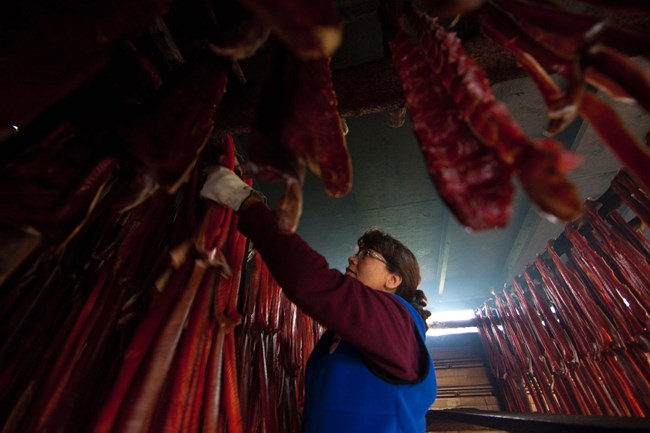|
"Encompassing more than 13 million acres of land and some of the highest peaks on North America, Wrangell-St. Elias National Park and Preserve is the largest conservation unit managed by the National Park Service. Given the park’s size and its location in Alaska, many visitors view it as an uninhabited wilderness. Yet to Athabascan and Tlingit people, much of the park is home—a cultural landscape within which they have hunted, trapped, fished, gathered, and lived for generations, a landscape crisscrossed with networks of trails and travel routes." From Along the Ałts'e'tnaey-Nal'cine Trail, Beeter, Cellarius, & Simeone, 2014. 
NPS/Neal Herbert 
NPS A Vast WildernessThe Wrangell-St. Elias Wilderness is large and complex. It is both beautiful and rugged; delicate, yet dangerous. The four mountain ranges that make up the Wrangell-St. Elias Wilderness emerge from the earth like massive transoceanic waves made of soil, rock, and ice. This wilderness is the largest unit of the National Wilderness Preservation System, encompassing over 9.4 million acres of designated wilderness and 2.5 million acres of eligible wilderness. Those who enter this magnificent landscape will find an immense environment that demands a high degree of self-reliance. Wilderness DefinedThe Wrangell-St. Elias Wilderness was designated in 1980 by the Alaska National Interest Lands Conservation Act, which created a more human-centric lens for wilderness stewardship than that which is found outside the state. However, the NPS’s primary mandate is the same across all federal lands: to preserve wilderness character. The holistic concept of wilderness character protects the biophysical environment, personal experiences, and symbolic meanings that collectively distinguish wilderness from general backcountry and front country areas. Unique social, cultural, and ecological benefits of wilderness are rooted in wilderness character preservation. 
NPS Indigenous HomelandsPeople have lived and used the lands now known as Wrangell-St. Elias National Park and Preserve since time immemorial. The Ahtna, Upper Tanana, Eyak, and Yakutat Tlingit peoples know this wilderness as their homeland. Historically, the Ahtna and Upper Tanana Athabascans resided in the interior lands now within the national park and preserve. The Ahtna Kohtaene resided among the Wrangell Mountains. Mt. Drum is called Hwdaandi K’ełt’aeni, Mt. Sanford is Hwiindi K’ełt’aeni, and Wrangell is K’ełt’aeni, (The One that Controls the Weather) and when smoking, Uk'ełedi (The One with Smoke on It). Their neighbors just beyond the ridges, the Upper Tanana, called the Wrangell Mountains Theetsaa Tł’aat (Copper Headwaters), as it is the watershed source of the Copper River.
Further south, the Eyak and the Tlingit live in coastal villages near the Gulf of Alaska. Travel routes through the wilderness demonstrate that the Eyak in the area now known as Cordova and the Tlingit in Yakutat traded and bartered with the Ahtna and the Upper Tanana peoples during pre-contact times. Tlingit names are Sit' Tlein for the Hubbard Glacier and Malaspina (Big Glacier) and Was'eitushaa for Mount St. Elias (Mountain Inland of Was'ei (Icy Bay)).
Today, the Ahtna, Upper Tanana, Eyak, and Tlingit continue to use the lands that encompass the Wrangell-St. Elias Wilderness. Their identity is embedded in the earth, braided rivers, and weather patterns. Local residents are intimately familiar with the landscape just as their ancestors have been for centuries. Wilderness CharacterThe Wrangell-St. Elias Wilderness is at the nexus of culture, history, and adventure. It is revered as a prime example of a wild landscape. With an average park visitation of 65K recreational visits per year, visitors are drawn to the park’s impressive vistas, waterways, historic mines, sport hunting and fishing opportunities, and the vast backcountry and expanses of wilderness. Much of what draws people to the Wrangell-St. Elias Wilderness is reflected in the park’s Wilderness Character Narrative. Wilderness SafetyThough rewarding, visiting Wrangell-St. Elias Wilderness can be a challenging place that carries inherent risk. Adventures in this remote and isolated area demand self-sufficiency. Remember to plan ahead and be prepared before exploring this beautiful, vast, and remote area. Learn more about visiting the Wrangell-St. Elias Wilderness:
Wrangell-St. Elias Wilderness Map
|
Last updated: September 10, 2025
